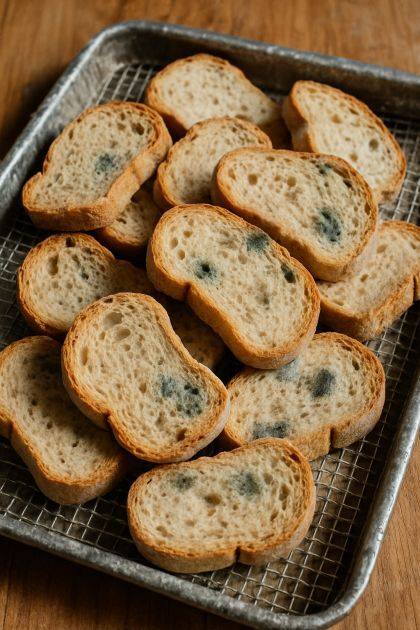Pulled out some stale bread from pantry. My mother-in-law says it’s wasteful not to use it, but it looks bad to me. What should I do?
We’ve All Been There…
You reach into the pantry craving a fresh slice of bread—only to find it’s gone dry and stiff. Disappointing? Sure. But before tossing it in the trash, maybe you can hear your mother-in-law’s voice reminding you, “It’s wasteful not to use it.”
This familiar kitchen dilemma—whether to toss or rescue stale bread—is more common than you think.
What Does “Stale” Really Mean?
When bread goes stale, it hasn’t spoiled—it’s just lost moisture and become dry or firm. This process, called retrogradation, occurs when the starches in the bread change and release water. It often sets in just days after baking, especially if bread isn’t stored properly.
The key difference? Stale isn’t moldy. While dry bread is usually safe, moldy bread is not.
Is It Still Safe to Eat?
Yes—as long as there’s no mold, stale bread is generally fine to eat.
Watch out for:
- Fuzzy patches (white, green, or black)
- Off smells
- Odd texture beyond just dryness
Mold means it’s time to say goodbye. But if your bread is simply hard and dry, you can repurpose it in plenty of tasty ways.
Why It Matters: Bread & Food Waste
Did you know bread is one of the most commonly wasted food items globally? Each year, 1.3 billion tons of food go to waste—and that waste includes the energy, water, and labor used to produce it. Plus, when food ends up in landfills, it releases greenhouse gases that harm the planet.
By rethinking how we use stale bread, we take a small step toward reducing food waste and making smarter, more sustainable food choices.
Easy Ways to Revive & Reuse Stale Bread
Stale bread doesn’t have to end up in the bin. Try these simple tricks:
- Revive in the oven: Lightly mist the bread with water and warm it at 350°F (175°C) for 8–10 minutes. This helps restore moisture and softens the loaf.
- Use it in moist recipes: Dishes like French toast, bread pudding, or savory stuffing naturally bring stale bread back to life.
Internet-Approved Hacks
Social media is packed with genius stale bread ideas:
- Homemade breadcrumbs: Toss dried bread into a food processor for quick breadcrumbs. Great for coating chicken, topping casseroles, or thickening soups.
- Crispy croutons: Cut into cubes, toss with olive oil and seasoning, and bake until golden. Perfect for soups or salads.
Does Staleness Affect Nutrition?
Not much.
Stale bread retains most of its carbs, fiber, and nutrients, especially if it’s whole grain or fortified. The biggest difference is texture—not nutritional value. Just be aware that added nutrients (in enriched bread) may slightly decline over time.
Storage Tips to Keep Bread Fresher Longer
Want to keep your bread fresh? Avoid the fridge—it speeds up staling. Instead:
- Store in a bread box or paper bag at room temperature
- For long-term storage, freeze it: wrap tightly and place in a freezer-safe bag. Thaw at room temperature or toast straight from the freezer.
When to Let It Go
Even with the best intentions, some bread is too far gone. Toss it if:
- You see mold anywhere (even a small patch)
- It smells off or has an odd taste
- It’s rock hard or feels like it could chip a tooth
Better safe than sorry!
How Cultures View Bread Waste Differently
Around the world, stale bread is seen in very different lights. In Europe, many traditional dishes like French pain perdu (French toast) or Italian panzanella (bread salad) make use of old bread. These time-honored recipes prove that good food doesn’t need to be fresh to be delicious.
Elsewhere, the preference for ultra-fresh food can lead to perfectly edible bread being discarded. Understanding these cultural contrasts can inspire us to think differently about our own food habits.
What Chefs Say About Stale Bread
For many chefs, stale bread isn’t a problem—it’s an ingredient. Culinary leaders like Chef Massimo Bottura have built entire dishes around using stale bread and other leftovers to promote zero-waste cooking.
Their creativity shows how leftovers can become luxury with the right mindset—and a little imagination.
Final Thoughts: Use It or Lose It?
When deciding whether to use stale bread, consider three things:
- Is it safe? (No mold or off smells?)
- Can you make it tasty?
- What’s the environmental impact?
